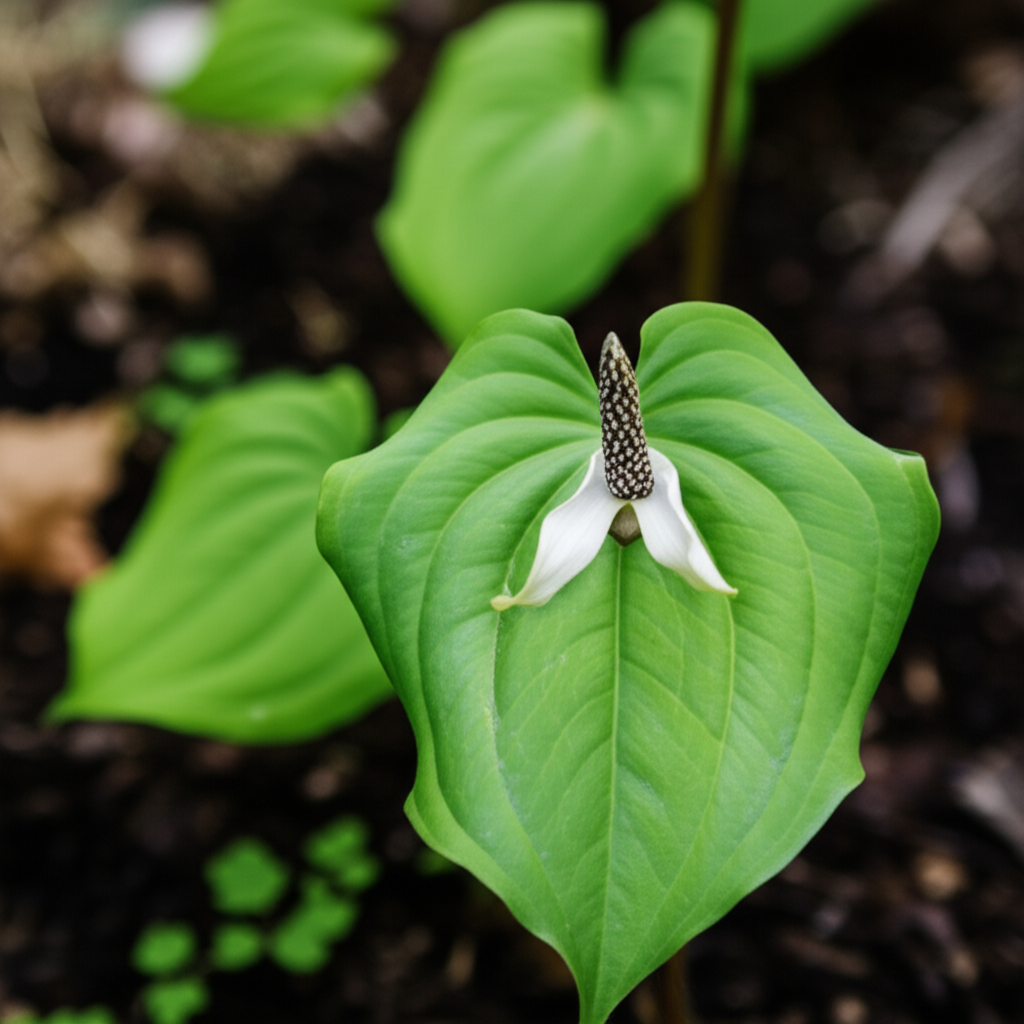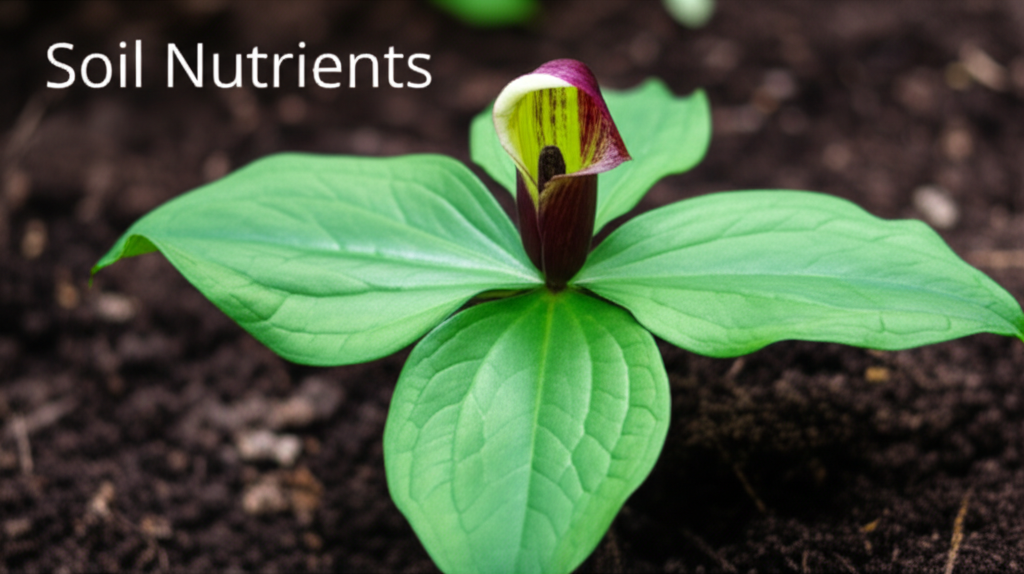Understanding the Jack-in-the-Pulpit’s Soil Needs
The captivating Jack-in-the-Pulpit (Arisaema triphyllum) is a woodland wildflower that thrives in specific soil conditions. While it’s known for its resilience and unique aesthetic, achieving vigorous growth and abundant flowering hinges on providing the right soil environment. A critical aspect of this is understanding and managing the nutrient content of its growing medium. This article delves into the intricacies of Jack-in-the-Pulpit soil nutrient testing and the adjustments necessary to cultivate these fascinating plants successfully.
Why Soil Nutrients Matter for Jack-in-the-Pulpit

Jack-in-the-Pulpit, a native of moist, deciduous woodlands, has evolved to thrive in environments rich in organic matter and with a balanced supply of essential nutrients. These plants are not heavy feeders in the typical garden sense, but deficiencies or excesses of certain nutrients can significantly impact their health, growth rate, and ability to reproduce.
Key Nutrients for Jack-in-the-Pulpit
The primary macronutrients and micronutrients that play a role in Jack-in-the-Pulpit’s development include:
- Nitrogen (N): Crucial for leafy green growth and overall plant vigor. Too little nitrogen results in stunted, yellowish foliage. Too much can lead to excessive leaf production at the expense of corms and flowers, and can make the plant more susceptible to pests and diseases.
- Phosphorus (P): Essential for root development, flowering, and seed production. Adequate phosphorus promotes a strong corm and supports the energy required for blooming.
- Potassium (K): Important for overall plant health, disease resistance, and water regulation. Potassium helps strengthen the plant’s tissues and aids in nutrient transport.
- Calcium (Ca): Vital for cell wall structure and nutrient uptake. Deficiencies can lead to weak growth and deformities.
- Magnesium (Mg): A key component of chlorophyll, essential for photosynthesis. Low magnesium can manifest as yellowing between leaf veins.
- Sulfur (S): Involved in protein synthesis and enzyme activity.
- Micronutrients (e.g., Iron, Manganese, Zinc): Required in smaller amounts but are critical for various enzymatic processes and plant functions.
Testing Your Jack-in-the-Pulpit Soil
Before making any adjustments, it’s imperative to understand the current state of your soil’s nutrient profile. Soil testing provides a scientific basis for informed decisions, preventing guesswork and potential harm to your plants.
Methods of Soil Testing
There are several ways to test your soil:
1. Home Soil Test Kits
These kits are readily available at garden centers and online. They typically test for major macronutrients (N-P-K), as well as pH and sometimes calcium and magnesium.
- Pros: Affordable, convenient, provides a quick estimate of nutrient levels.
- Cons: Generally less accurate and comprehensive than laboratory tests, can sometimes be difficult to interpret.
2. Professional Laboratory Soil Analysis
This is the most accurate and comprehensive method. You collect a soil sample and send it to a reputable soil testing laboratory. They will analyze a wide range of nutrients, organic matter content, and pH, providing detailed reports and often recommendations.
- Pros: Highly accurate, provides detailed information on a broad spectrum of nutrients, often includes specific recommendations tailored to your needs.
- Cons: More expensive than home kits, requires more time to get results.
What to Test For
When testing soil for Jack-in-the-Pulpit, prioritize the following:
- pH: Jack-in-the-Pulpit prefers slightly acidic to neutral soil, ideally between 5.5 and 7.0. pH affects nutrient availability.
- Organic Matter Content: A high organic matter content (5% or more) is ideal, as it improves soil structure, water retention, and provides a slow release of nutrients.
- Macronutrients (N-P-K): Essential for basic plant functions.
- Calcium and Magnesium: Important for structural integrity and chlorophyll production.
Collecting a Soil Sample
For accurate results, proper sample collection is key:
- Collect samples from several areas within the planting zone, avoiding areas of recent fertilization or unusual soil.
- Use a clean trowel or soil probe.
- Dig down about 4-6 inches, taking a uniform sample from that depth.
- Combine samples from different locations into a clean container.
- If sending to a lab, follow their specific packaging and submission instructions.
Interpreting Your Soil Test Results
Once you have your test results, the next step is to understand what they mean for your Jack-in-the-Pulpit. Soil test reports typically categorize nutrient levels as deficient, low, medium, high, or excessive.
Understanding pH Levels
- pH < 5.5: Too acidic. Nutrients like phosphorus, potassium, calcium, and magnesium may be less available.
- pH 5.5 – 7.0: Ideal range for Jack-in-the-Pulpit. Most nutrients are readily available.
- pH > 7.0: Too alkaline. Iron and other micronutrients can become locked up, leading to deficiencies.
Nutrient Levels
For Jack-in-the-Pulpit, a “medium” or “adequate” level for most nutrients is generally sufficient. They do not require heavily fertilized conditions. Focus on avoiding extremes.
| Nutrient | Ideal Range/Level | Deficiency Symptoms | Excess Symptoms |
|---|---|---|---|
| pH | 5.5 – 7.0 | Stunted growth, poor nutrient uptake (if too low/high) | Nutrient lockout (if too low/high) |
| Organic Matter | 5% + | Poor drainage, rapid drying, low nutrient retention | Can lead to anaerobic conditions if excessive and poorly draining |
| Nitrogen (N) | Adequate/Moderate | Yellowing leaves (chlorosis), stunted growth | Excessive leaf growth, reduced flowering/corm production, increased disease susceptibility |
| Phosphorus (P) | Adequate/Moderate | Poor root development, reduced flowering, purplish tinge on leaves | Generally less common to over-apply through organic amendments, can interfere with micronutrient uptake |
| Potassium (K) | Adequate/Moderate | Weak stems, increased susceptibility to disease and drought stress | Can interfere with uptake of other cations (calcium, magnesium) |
| Calcium (Ca) | Adequate | Poor root growth, deformed leaves, weak cell structure | Can interfere with magnesium and potassium uptake |
| Magnesium (Mg) | Adequate | Yellowing between veins (interveinal chlorosis) on older leaves | Can interfere with calcium uptake |
Adjusting Soil Nutrients for Optimal Jack-in-the-Pulpit Growth
Once you have identified any nutrient imbalances or suboptimal conditions, you can implement targeted adjustments. The key is to work with the plant’s natural preferences, focusing on building healthy, living soil.
Adjusting pH
- To lower pH (make more acidic): Incorporate elemental sulfur or acidic organic matter like peat moss or pine needles. Apply gradually over time.
- To raise pH (make more alkaline): Add lime (e.g., dolomitic lime, which also adds magnesium). Apply in fall or early spring, before planting.
Boosting Organic Matter
This is perhaps the most beneficial adjustment for Jack-in-the-Pulpit.
- Compost: Well-rotted compost is an excellent soil amendment. It improves drainage, aeration, and water retention while providing a slow release of nutrients.
- Leaf Mold: Decomposed leaves are a natural and highly beneficial amendment, mimicking the woodland environment.
- Aged Manure: Use only well-composted manure, as fresh manure can burn roots and introduce pathogens.
Incorporate these amendments into the top few inches of soil annually, especially in the fall.
Addressing Specific Nutrient Deficiencies (with Caution)
It’s important to note that for Jack-in-the-Pulpit, nutrient deficiencies are often linked to poor soil structure or low organic matter rather than a direct lack of applied fertilizers.
- Nitrogen: A light application of compost or a balanced organic fertilizer (e.g., 5-5-5) in early spring can be beneficial if nitrogen is low. Avoid high-nitrogen synthetic fertilizers.
- Phosphorus: Bone meal is a common organic source of phosphorus. Use sparingly and only if a deficiency is confirmed by testing.
- Potassium: Wood ash (sparingly and only if pH is low) or kelp meal can supply potassium.
- Magnesium: Epsom salts (magnesium sulfate) can be applied as a foliar spray or soil drench if a deficiency is confirmed. Dolomitic lime also adds magnesium.
General Best Practices for Nutrient Management
- Prioritize Organic Amendments: These provide a slow, steady release of nutrients and improve soil health over time.
- Avoid Over-Fertilizing: Jack-in-the-Pulpits are woodland plants, not heavy feeders. Excess fertilizer can lead to weak growth and damage.
- Timing is Key: Apply amendments in fall or early spring, allowing them time to integrate into the soil before the plant’s active growing season.
- Mulching: A layer of organic mulch (leaf litter, shredded bark) helps retain moisture, suppress weeds, and slowly decomposes, adding nutrients to the soil.
- Observe Your Plants: Your Jack-in-the-Pulpits are excellent indicators. Yellowing leaves, stunted growth, or a lack of flowering can all signal underlying soil issues that may be nutrient-related.
Troubleshooting Common Soil Issues
| Problem | Likely Cause | Solution |
|---|---|---|
| Yellowing Leaves (Chlorosis) | Low Nitrogen, Low Magnesium, or Incorrect pH (nutrient lockout) | Test soil for N, Mg, and pH. Amend with compost, Epsom salts (for Mg), or adjust pH if necessary. |
| Stunted Growth | Low overall nutrients, poor drainage, incorrect pH, lack of organic matter | Incorporate compost, test soil for N-P-K and pH, ensure adequate moisture and drainage. |
| No Flowers or Poor Flowering | Insufficient Phosphorus, stress, or insufficient energy reserves in the corm | Ensure adequate phosphorus (check soil test), provide optimal growing conditions, avoid excessive nitrogen. |
| Wilting despite watering | Poor drainage (root rot), or extremely low organic matter leading to rapid drying | Improve drainage by adding compost and grit; ensure planting in well-draining soil. |
Conclusion: Cultivating a Thriving Jack-in-the-Pulpit Ecosystem
Providing the right soil conditions is fundamental to the success of your Jack-in-the-Pulpit. By taking the time to test your soil’s nutrient profile and pH, and by making judicious adjustments with organic amendments, you can create an environment that fosters vigorous growth, vibrant foliage, and the reliable emergence of its iconic bloom. Remember, healthy soil is a living ecosystem, and by nurturing it, you nurture your plants. Regular observation and a commitment to organic practices will ensure your Jack-in-the-Pulpits remain a captivating feature of your garden for years to come.


